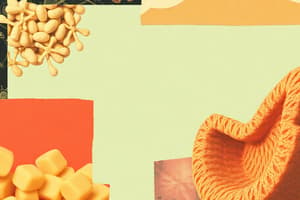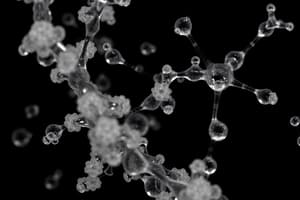Podcast
Questions and Answers
What type of fats are typically solid at room temperature?
What type of fats are typically solid at room temperature?
- Unsaturated fats
- Phospholipids
- Saturated fats (correct)
- Trans fats
Which of the following is a characteristic of unsaturated fats?
Which of the following is a characteristic of unsaturated fats?
- They have fatty acids that can contain double bonds. (correct)
- They contribute less to cardiovascular disease than saturated fats.
- Most animal fats are classified as unsaturated.
- They are solid at room temperature.
What is the process of hydrogenation primarily used for?
What is the process of hydrogenation primarily used for?
- To convert saturated fats into oils
- To convert unsaturated fats into saturated fats (correct)
- To break down saturated fats
- To enhance the nutritional value of fats
Which of the following fatty acids must be acquired through diet due to the body not synthesizing them?
Which of the following fatty acids must be acquired through diet due to the body not synthesizing them?
What is the primary function of fats in the human body?
What is the primary function of fats in the human body?
What component forms the basic structure of a nucleotide?
What component forms the basic structure of a nucleotide?
Which structure connects adjacent nucleotides in a polynucleotide?
Which structure connects adjacent nucleotides in a polynucleotide?
Which of the following nitrogenous bases is NOT a pyrimidine?
Which of the following nitrogenous bases is NOT a pyrimidine?
What type of sugar is found in RNA nucleotides?
What type of sugar is found in RNA nucleotides?
How many rings comprise purine nitrogenous bases?
How many rings comprise purine nitrogenous bases?
Which of the following is a feature of the sugar-phosphate backbone in nucleic acids?
Which of the following is a feature of the sugar-phosphate backbone in nucleic acids?
What is the role of the –OH group on the 3' carbon in nucleotide linking?
What is the role of the –OH group on the 3' carbon in nucleotide linking?
Which statement accurately describes the sequence of bases in a DNA or mRNA polymer?
Which statement accurately describes the sequence of bases in a DNA or mRNA polymer?
What type of reaction is involved in the synthesis of maltose from glucose?
What type of reaction is involved in the synthesis of maltose from glucose?
What are the primary roles of polysaccharides?
What are the primary roles of polysaccharides?
Which statement correctly describes starch?
Which statement correctly describes starch?
Where is glycogen primarily stored in humans?
Where is glycogen primarily stored in humans?
What distinguishes cellulose from starch?
What distinguishes cellulose from starch?
What is the simplest form of starch?
What is the simplest form of starch?
Which two ring forms of glucose influence the glycosidic linkages in polysaccharides?
Which two ring forms of glucose influence the glycosidic linkages in polysaccharides?
What component of plant cells is cellulose primarily associated with?
What component of plant cells is cellulose primarily associated with?
What is the primary function of enzymes in biological systems?
What is the primary function of enzymes in biological systems?
How are polypeptides formed?
How are polypeptides formed?
Which of the following statements about amino acids is true?
Which of the following statements about amino acids is true?
What is the composition of a protein?
What is the composition of a protein?
Which type of side chains leads to polar and hydrophilic properties in amino acids?
Which type of side chains leads to polar and hydrophilic properties in amino acids?
What differentiates the various amino acids from one another?
What differentiates the various amino acids from one another?
What characterizes the ends of a polypeptide chain?
What characterizes the ends of a polypeptide chain?
What type of tissue is collagen primarily associated with?
What type of tissue is collagen primarily associated with?
What is the primary role of DNA in terms of protein synthesis?
What is the primary role of DNA in terms of protein synthesis?
Which of the following correctly describes the structure of a nucleotide?
Which of the following correctly describes the structure of a nucleotide?
What is the primary function of RNA polymerase II in the process of gene expression?
What is the primary function of RNA polymerase II in the process of gene expression?
Where does the synthesis of mRNA occur within a cell?
Where does the synthesis of mRNA occur within a cell?
What term describes the polymer formed by nucleotides?
What term describes the polymer formed by nucleotides?
During protein synthesis, what is the first step after mRNA moves into the cytoplasm?
During protein synthesis, what is the first step after mRNA moves into the cytoplasm?
Which type of nucleic acid is responsible for carrying the genetic information from DNA to the ribosome?
Which type of nucleic acid is responsible for carrying the genetic information from DNA to the ribosome?
Which statement is true regarding the components of a nucleic acid?
Which statement is true regarding the components of a nucleic acid?
Flashcards are hidden until you start studying
Study Notes
Disaccharides
- Maltose is made from the dehydration reaction of two glucose monomers linked by a 1–4 glycosidic linkage
- Sucrose is made from the dehydration reaction of one glucose and one frutose monomers linked by a 1–2 glycosidic linkage
Storage Polysaccharides
- Starch is the major storage polysaccharide in plants and is made of entirely glucose monomers
- Starch is stored in granules within chloroplasts and other plastids
- Amylose is the simplest form of starch, it's unbranched
- Glycogen is the major storage polysaccharide in animals, such as humans, stored in liver and muscle cells
Structural Polysaccharides
- Cellulose is a major component of plant cell walls, its a polymer of glucose monomers linked by beta glycosidic linkages
- Different linkages impact the shape of the molecule, determining its function.
Nucleic Acids
- Nucleic acids are polymers called polynucleotides
- Each polynucleotide is made of monomers called nucleotides
- Each nucleotide consists of a nitrogenous base, a pentose sugar, and one or more phosphate groups
- The portion of a nucleotide without the phosphate group is called a nucleoside
- There are two families of nitrogenous bases:
- Pyrimidines (cytosine, thymine, and uracil) have a single six-membered ring
- Purines (adenine and guanine) have a six-membered ring fused to a five-membered ring
- In DNA, the sugar is deoxyribose; in RNA, the sugar is ribose
Protein Structure
- Proteins are biological functional macromolecules, made of one or more polypeptides
- Polypeptides are unbranched polymers built from the same set of 20 amino acids
- Amino acids are organic molecules with carboxyl and amino groups
- Amino acids differ in their properties due to differing side chains, called R groups
- There are different types of amino acids based on their side chains and properties:
- Nonpolar, hydrophobic
- Polar, hydrophilic
- Electrically charged, hydrophilic
- Amino acids are linked by peptide bonds
- Each polypeptide has a unique linear sequence of amino acids, with a carboxyl end (C-terminus) and an amino end (N-terminus)
Fats (Lipids)
- Fats are lipids made of glycerol and fatty acids
- Fatty acids vary in length and the number and location of double bonds
- Saturated Fats:
- Made from saturated fatty acids
- Solid at room temperature
- Mostly found in animal fats
- Unsaturated Fats:
- Made from unsaturated fatty acids
- Liquid at room temperature
- Mostly found in plant fats and fish oils
- Hydrogenation:
- Process of converting unsaturated fats to saturated fats by adding hydrogen
- Can create trans fats, which are worse for cardiovascular health than saturated fats
- Essential fatty acids:
- Some unsaturated fatty acids are not synthesized by the human body and must be supplied through diet
- Include omega-3 fatty acids, which are important for growth and cardiovascular health
Phospholipids
- Phospholipids have two fatty acid tails attached to glycerol and a phosphate group
- The tails are hydrophobic, while the phosphate group and attachments form a hydrophilic head
- This structure makes them important components of cell membranes
Roles of Proteins
- Enzymes are proteins that act as catalysts to speed up chemical reactions
- Proteins are involved in multiple functions, including muscle tissue, connective tissue, and more.
Studying That Suits You
Use AI to generate personalized quizzes and flashcards to suit your learning preferences.




